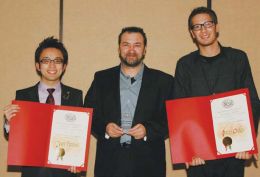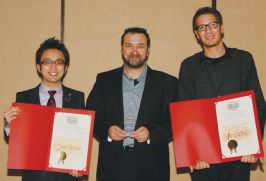Caricature: Providing a New Lease on Life
 Dan Almariei’s first convention in Las Vegas, 2010. | |
| Author | Melissa Sarieka Almariei |
|---|---|
| Subject | Dan Almariei |
| Genre | Article, Member Spotlight |
Publication date | Fall 2019 |
| Media type | Digital, |
| Pages | 27-29 |
| Website | caricature |

Article Description. Should include author, brief description, issue number and page number(s).
Article Transcript
Dan Almariei is not known for being one of the fastest caricature artists in the industry and could be considered one of the slowest. He prides himself on quality of work over the speed of his live caricature sketch. In a world of fast caricaturists, he explains the difference in the quality versus speed. Although he may spend 8 to 10 minutes on a caricature, his 10-minute sketch would take over an hour for many others. In detail, shading and quality, he could be considered very fast.
In the late 1980s, Romania was under the rule of Nicolae Ceaușescu. Dan escaped Romania with two friends as refugees. They were shot at, captured and later released. Arriving in France as a foreigner in a strange land, he learned to speak French quickly and obtained a job in monument restoration, working on museums and buildings in Paris such as the Louvre, The Basilica St. Denis, Opera, The Conservatory of Arts and Crafts, The Church St. Bernard and a few others. The influence of his view as a sculptor regarding light and forms can later be seen in his unique way of shading caricatures.
A year later, his paperwork did not transfer from Romania. He lost his sculpting job and was on the brink of homelessness. As a starving artist, he walked the streets of Paris, contemplating a solution. Meals of chicken bouillon mixed with hot water were barely a livelihood to survive, and scraping by was a daily struggle. There had to be a better way. He saw the street caricature artists and wondered if he could do that. With no resources, in desperation he decided to gather supplies. He picked up other artists’ scraps; broken charcoal, paper that had been disposed of and a small board to set up to draw his first caricature.
A patron approached Dan and asked how much to draw his daughter. With barely a shred of confidence, Dan meekly stated the price as a question: “Thirty Francs?” The patron agreed. Dan started his first caricature with sweaty palms, heart in his throat and a throbbing in his head. The fear of rejection was real, and he was nervous as he bravely sat and drew as onlookers watched. Upon completion of the sketch, the client was satisfied with the drawing and paid. He immediately took the money, ran to buy a sandwich and scarfed it down. With a twinkle in his eye and new hope, this began Dan Almariei’s career as a caricaturist.
In 1989, the Berlin Wall fell and Ceaușescu was overthrown, marking the end of the Communist regime in Romania. Dan was no longer a refugee and was able to work legally in France and return to monument restoration. But he had fallen in love with caricatures, never to return to his original trade.
Working as a street caricature artist in France for over 20 years, he became well known to the artists in France and participated in several festivals, including Festival of St. Esteve (France), The Portrait and Caricature Festival in Ancona (Italy), the Graphic Arts Festival in Gan (France), The Week-End Cartoon Festival (Ireland), The Caricature Festival in Castelnaudary (France), The Caricature Festival in Tourtrol (France) and The Festival of Humour and Editorial Cartoons in St. Just Le Martel (France). A few publications around the world showcased his work. He was well known in the caricature community, won awards and prizes (such as his weight in wine) and was published in several countries and featured in exhibits.
While still drawing live caricatures, his career branched out to graphic design and computer science, enabling him to teach web development and graphic design at IDEM Formation, a Creative Arts School (France), and fine arts approach in a local center in Palau Del Vidre (France).
In 1998, he created Caricature Planet, an online community for caricaturists, illustrators and press cartoonists from around the world that featured directories with festivals and connected them together. He administered Caricature Planet until he moved to the U.S. in 2009.
He joined ISCA in 2010, when he attended his first ISCA convention. Dan is not a competitive type and is more of a social person, but he still won awards for Best Likeness, Outstanding Black & White Technique, 7th place Caricaturist of the year and 3rd and 4th Place Caricature of the Year. In 2012-2013, he had the opportunity to serve on the ISCA Board; however, he left the board to support and assist his future wife, Melissa, and her family while her father died of cancer shortly after the 2013 ISCA Convention.
An influence on his peers, students and patrons, he is friends with many caricaturists and cartoonists around the world and is open to give advice and spend time sharing his knowledge. His involvement with diverse art groups deeply saddened him when he lost friends after the Charlie Hebdo shooting.
After moving to the United States, he noted a difference in the way art was viewed in the U.S. in comparison to France and explains that in the U.S., artists are sometimes viewed as a lower end of social class, almost childlike, and society expects artists to draw or give away their work for free. In Europe, art is considered a “real” profession. People there would not expect free work, and they recognize it as a viable trade.
Many Americans view art in museums with high regard but view the caricature/street artists as somehow inferior or as a level beneath other professions. Dan says that in Europe, France particularly, caricature and street artists are highly revered by society as an important asset to the art world, considering that is where many of the artists in museums originate.
This higher appreciation of art in Europe lead him to question why clients in the U.S. inquired about how fast he could draw. He didn’t understand why the speed was more important than quality of art. The public pay more for live caricatures in Europe than in the U.S. because American artists don’t understand the value of themselves, or their original art.
Dan is “the artist” at events, and patrons understand that he is not the fastest artist and still appreciate his work. Despite his live sketch speed, he maintains that he is not the slowest artist and recounts stories of a slower caricaturist than him that drew at the European festivals that would spend over an hour to draw a person, and people patiently waited. That artist was Sebastian Krüger.
Is speed a factor? It depends on the client and their needs. Dan understands this is a different society and will stick to his style and cultural differences to produce the art that makes him “Dan.” You want speed? Sorry, Sandra. Sorry, Keanu. You aren’t going to get it from Dan Almariei. Sit back, take your time and let the artist draw you in his style.
Dan and his wife, Melissa, provide caricatures and facepainting in central Florida. Find out more about them on their Facebook page @CaricatureHut.
See Also
External Links
This Navigation box may not show up on mobile browsers. Please see Exaggerated Features Issue 2019.4 for the full contents of this issue if the navigation box does not display.
